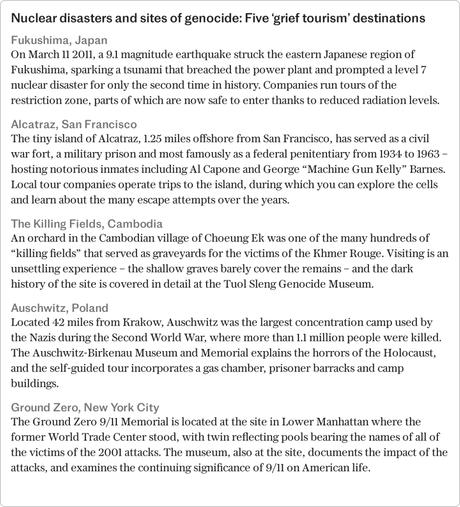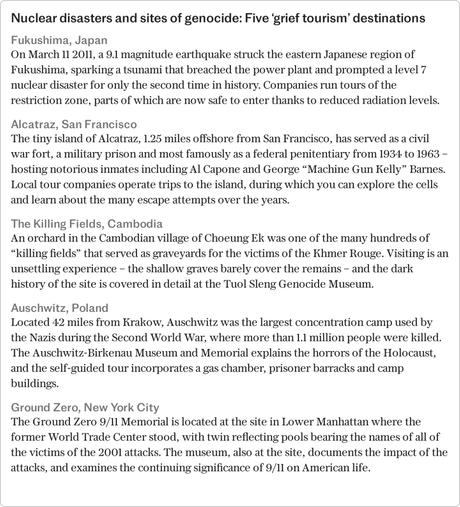
Cruise ships dominate the skyline of the Jamaican town of Falmouth as holidaymakers rush off in search of the sun and sand, dominating tourism on the island.
But in the shadows of the hulking Royal Caribbean ships lie the docks where African slaves once landed and never disembarked, along with the crumbling homes and offices where brutal slavery was counted.
Most of Jamaica's three million annual visitors will pass by these Georgian remnants of the British slave economy and the history that comes with it.
Plans are now underway to lure 'dark tourists' seeking out places of suffering - and rotting architectural gems could be saved in the process.
The industry of 'grief tourism' has drawn visitors - and money - to locations from the Killing Fields of Cambodia to the shell-strewn streets of Sarajevo, and the growing taste for seeing the scenes of horror known from the news or the history books did not. went unnoticed in Jamaica.
Edmund Bartlett, the country's Minister of Tourism, has written a book entitled Decoding the future of tourism resilience which includes a chapter on the potential of more morbid destinations.
He told it The Telegraph that he looks at Jamaica's potential as a destination for those who want to see and understand the inequalities of slavery. The country's slave economy produced fortunes in sugar during the 300 years of British rule.
The right-wing Labor Party politician said he is working closely with the Ministry of Culture and the Jamaica National Heritage Trust to ensure "conservation work and restoration of historic sites and monuments" linked to the colonial past.
One project is already underway in Falmouth. The Port Authority, a Jamaican government agency, is paying to renovate a house on the harbor that belonged to John Tharp (1744-1804), the largest slave owner on the island, with about 2,500.
The gutted 230-year-old mansion is being restored to its original Georgian splendor, with the express purpose of becoming a museum telling the story of Tharp's affairs and the impact of slavery on the island, where tourists and locals alike would like to forget.
The story continues
This conservation process has pleased groups such as the Friends of the Georgian Society of Jamaica, who have long advocated for the 18th century architectural gems of Falmouth, and Jamaica in general, to be preserved. And conservation and tourism profits can go hand in hand.
Tharp's slaves are said to have been transported from the port to his vast estate in the inland Good Hope high country, where an elegant plantation home sits above the forest cloud and where Georgian bridges, sugar mills, a watermill and a bridge all survive.
Good Hope's sugar cane has made way for a 2,000-acre citrus and coconut farm, purchased by Jamaican businessman Tony Hart and inherited by his son Blaise, who has worked to preserve the historic site and make it profitable.
"There were six people working here when my father bought it, and now there are almost a hundred," he says. "Good Hope needed a lot of restoration, which was a journey in itself."
Founded in 1744, the estate is now a profitable destination for weddings and psychedelic mushroom retreats and also contains an almost unique example of a surviving slave village: crude settlements that have largely disappeared without a trace elsewhere on the island.
The "mourning tourist" can gaze at the buildings that shaped the lives of the slaves: the squat stone foundations of their small homes, the burned-out ruins of the hospital where they were treated, the cookhouse where they processed sugar cane into crystals. and offices of those who direct their labor.
In the "big house" - where Tharp once lived - verandas, blinds and sash windows show how houses were designed to keep the plantocracy cool in the tropical heat.
Mr Hart has suggested that the appeal of grief tourism to surviving and potentially unpopular plantation houses - many of which were burned down by rebel slaves led by Sam Sharpe in 1831 - could help preserve these decaying architectural gems.
"There are certainly places that have potential," he says. "There are some beautiful places."
Mr Hart counts as a neighbor the conservationist Christopher Ohrstrom, son of the late Mary, Viscountess Rothermere and former head of the World Monuments Fund, who has invested in preserving Falmouth's colonial heritage.
That's what the American investor said The Telegraph that it is difficult to deviate from Jamaica's offering of 'rum and reggae', but added that Bartlett is a 'smart guy', and that heritage tourism focusing on British slavery 'has potential' to make money and preserve British historic buildings that would otherwise fall into disrepair.
However, he admits that it can be difficult to justify funding the conservation of what some in Jamaica see as 'monuments of oppression', and Jamaican conservation architect Peter Francis claims: 'There is a stigma attached to the conservation of certain types of heritage . There is a whole discussion going on about reparations, and there is more interest in preserving things related to the immediate Jamaican heritage, Bob Marley and so on."
Peregrine Bryant, a British architect who advocates conservation in Jamaica, believes that, like the Colosseum, "many buildings from the past are cherished in today's world" and that they can be a "resource for tourism."
The tourism potential is reflected in a number of projects now in the pipeline that will focus on Jamaica's dark history. Once conquered from the Spanish in the 1650s, the island became first a den of piracy and then Britain's largest sugar producer, necessitating the import of 600,000 African slaves before the trade was abolished in 1807.
Port Royal, the former capital and first point of entry for many slaves until the 1692 earthquake, will become the site of a new £3 million state-of-the-art museum space to house the artefacts of colonial rule. on display, with funding again coming from the Port Authority.
"People go to Port Royal these days for rum and fish," says Jonathan Greenland, the British director of the National Museum Jamaica. 'But it was the center of British colonial life. Slaves worked there in the port."
He added: "Slavery is seen in everything here: in relationships, in culture, in health, in the sense of humor. It has had an impact. It is important that people learn about this history, in Jamaica and in Britain. There is an opportunity to tell this story here, where slavery was once so central."


Mr Greenland's office in downtown Kingston will oversee future phases of this project, which aims to preserve the potential landmarks of the British Naval Hospital that served sailors who kept the colonies in check, and a 17th century women's prison.
A new museum focusing on another dark episode in Jamaican history is being built in the renovated remains of the Morant Bay courthouse.
It was here, in 1865, that rebels led by clergyman Paul Bogle set fire to the courthouse, sparking an uprising that was controversially put down by Governor Edward John Eyre, at the cost of 400 lives, including women and children.
Mr Bartlett believes that visitors, who contribute £3 billion to the Jamaican economy, can confront the past where it is presented, whether in ruins, grand houses or new museums.
He said: "The values of that period did not see it as an evil, but saw it as an entrepreneurial activity, in the same way we see the production and buying of a smartphone. The next generation may see us as terrible people. So we sometimes have to be careful about the way we make that characterization and make demands on the past.
"The other thing is that the past makes the future and helps define you. You can't change that definition, what you can do is improve it and make it better for the next generation."
